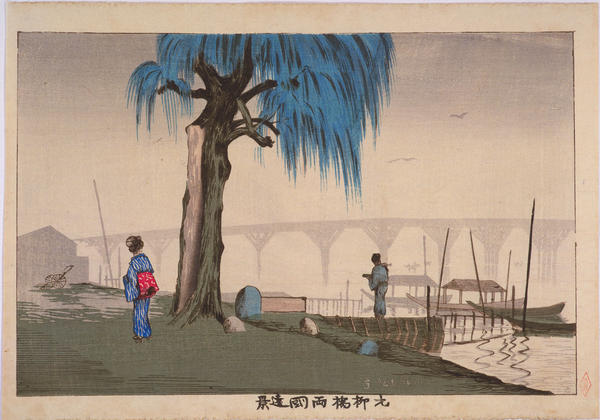Kobayashi Kiyochika (小林 清親, September 10, 1847 – November 28, 1915) was a Japanese ukiyo-e artist of the Meiji period.
Kiyochika is best known for his prints of scenes around Tokyo which reflect the transformations of modernity. He has been described as 'the last important ukiyo-e master and the first noteworthy print artist of modern Japan... [or, perhaps] an anachronistic survival from an earlier age, a minor hero whose best efforts to adapt ukiyo-e to the new world of Meiji Japan were not quite enough'.
The son of a government official, Kiyochika was heavily influenced by Western art, which he studied under Charles Wirgman. He also based a lot of his work on Western etchings, lithographs, and photographs which became widely available in Japan in the Meiji period. Kiyochika also studied Japanese art under the great artists Kawanabe Kyōsai and Shibata Zeshin.
His woodblock prints stand apart from those of the earlier Edo period, incorporating not only Western styles but also Western subjects, as he depicted the introduction of such things as horse-drawn carriages, clock towers, and railroads to Tokyo. These show considerable influence from the landscapes of Hokusai and the work of Utagawa Kuniyoshi, but the Western influence is also unquestionable; these are much darker images on the whole, and share many features with Western lithographs and etchings of the time.
These were produced primarily from 1876 to 1881; Kiyochika would continue to publish ukiyo-e prints for the rest of his life, but also worked extensively in illustrations and sketches for newspapers, magazines, and books. He also produced a number of prints depicting scenes from the Sino-Japanese War and Russo-Japanese War, collaborating with caption writer Koppi Dojin, penname of Nishimori Takeki (1861-1913), to contribute a number of illustrations to the propaganda series Nihon banzai hyakusen hyakushō ('Long live Japan: 100 victories, 100 laughs'). (from Wiki)
版画家。東京生。江戸本所御蔵屋敷の子。幼名は勝之助。画を志し、ワーグマン・河鍋暁斎・柴田是真に師事、浮世絵師として出発する。光線と影を取り入れた新様式の洋風版画は「光線画」の名で人気を博し、両国大火後は「清親ポンチ」と呼ばれる風刺画を『団団珍聞』などに描く。錦絵の衰退により肉筆画に移行した。大正4年(1915)歿、69才。


